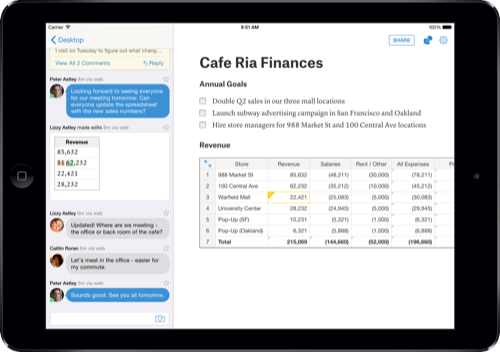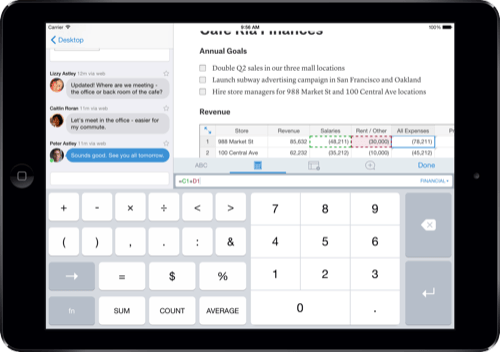
When is a spreadsheet not a spreadsheet?
The answer, according to Bret Taylor, is when it’s a Quip document.
Taylor, whose startup is challenging Microsoft, Google, and Apple in the market for mobile productivity tools, has just added features for slinging numbers alongside its existing tools for creating documents made of words.
See also: Quip Launches, Promising to Reinvent Word Processing In The Era Of The iPad
But Quip—just as it managed to have a very different take on word processing when it launched last summer—has introduced an entirely different way of including numbers in a document.
Spreadsheets? More Like Deadsheets
Put simply, you don’t have to choose between words or numbers in Quip 3.0. You just create a document, and you can add paragraphs, images, checklists, and now fully functional spreadsheets to it as you go.

Quip is thereby upending a status quo that has ruled spreadsheet software for three decades, since the rise of Lotus 1-2-3. Last month, IBM killed off the aging product, which was born in the earliest days of the PC era and helped make the original IBM PC a success. 1-2-3 may be dead, but its fundamental metaphors still rule products like Microsoft Excel, Google Sheets, and Apple’s Numbers app. A spreadsheet is a spreadsheet. A word-processing document is a word-processing document. And ne’er the twain shall meet.
If anything, Google’s taken a step backwards recently. When it introduced separate iPhone apps for word-processing and spreadsheets in April, users howled with discontent. (Previously, you could edit both kinds of documents in its Google Drive app.)
That world where you have to pick your app before you start creating a document is what Taylor’s trying to leave behind.

In a concession to the old ways—and the ingrained habits of its users—Quip lets you choose whether you’re creating a “document” or a “spreadsheet.” Under the hood, though, they’re the same thing on Quip—just different views of a collection of data.
Let’s say you’re doing a financial report which includes a year-to-date budget. A typical way to prepare that might be to break it into two documents, a narrative commentary and a structured spreadsheet. But when the numbers change in the spreadsheet, you’ve got to update the other document by hand.
In Quip, you can insert a reference to a row and column in an embedded spreadsheet, and it updates live. Flip to the sheet view, and you can manipulate the numbers much as you would in a conventional spreadsheet. On mobile devices—Quip is available on the Web, iOS, and Android—Quip has custom keyboards that pop up when you’re manipulating numbers, switching back to a regular keyboard when you’re entering text.

Days Of Feature Past
In the 1990s, Microsoft and Apple actually tried to accomplish something similar on their desktop operating systems through competing technologies—Microsoft’s OLE, short for Object Linking and Embedding, and Apple’s OpenDoc. The rise of the Web ended up rendering both more or less irrelevant, though OLE persists in the plumbing of Microsoft Windows. The legacy of these failed efforts: It remains difficult to combine words and numbers in modern documents, and even apps from the same company rarely play as nicely together as they should.
One way Lotus 1-2-3 and Quip are similar is how precisely they’re targeting their platforms. For Lotus 1-2-3, it was the IBM PC—and it beat competitors by writing directly to the PC’s video hardware, allowing it to draw spreadsheets on the screen much faster than other programs could.
For Quip, its playing field is mobile, and it’s hoping to beat its larger rivals with software tools designed for smartphones and tablets, not old desktop PCs. Alongside its new number-manipulating features, Quip is keeping all of the messaging tools that let you have a conversation about a document as you create it.
Taylor’s startup, which now has 22 employees, has found some success in its iconoclastic path. Facebook, where Taylor served as chief technology officer before leaving to start Quip, has more or less standardized on the app, he says. Besides Facebook, some 10,000 other companies now use Quip, a figure that has doubled since May. Quip charges businesses $12 per user per month, though some opt to use a more limited free version and larger companies can negotiate other plans.
Screenshots and photo of Bret Taylor courtesy of Quip









